A Tour of NYC's Newest Subway Station With Its Architect
New York City’s 469th subway station opened last week, extending the 7 line to 34th Street-Hudson Yards. It is New York’s first new station in 25 years, and has been a 13-year project for a team of designers led by WSP | Parsons Brinckerhoff. Dattner Architects served as the urban designer and design architect for the station, and I had the opportunity to tour the station with Beth Greenberg, principal in charge, and Emily Kotsaftis, project architect, from Dattner, to take a closer look at some of the subtle decision-making behind the light, bright, and (for now) disorientingly roomy station.
Where do you take a New York design writer who's seen everything? Orange County
An account by Carolina Miranda of our trip to Orange County, and the architecture we found there.
This week (weeks?) has been all about the Broad museum. The architecture. The art. The gala. All those Jeff Koons sculptures. Which means that flocks of national and international design critics have descended on Los Angeles to kick the tires on Eli Broad’s latest cultural venture. A lot of them are checking out other iconic L.A. architecture too — from George Wyman’s and Sumner P. Hunt’s 19th century Bradbury Building to Frank Gehry’s 21st century Disney Hall.
But only the most intrepid make it to Orange County.
My fellow writer-in-arms, Alexandra Lange, who writes for Curbed and the New Yorker, was in town to go Broading. But she also wanted to sneak a visit to that hidden Noguchi Garden that’s tucked into a corner behind a few corporate towers near South Coast Plaza. (Lange’s dissertation was on postwar American corporate modern architecture and design, and as part of that, she’s spent an awful lot of time looking at Noguchi’s work.)
Experiencing Architecture Through ‘Hippie Modernism’
Archizoom in “Hippie Modernism” at the Walker Art Center in Minneapolis. Courtesy Dario Bartolini.
In 1965, four artists bought seven acres in southeastern Colorado, intending to make live-in works of art. Their communal project came to be known as Drop City, where residents lived in zonohedron domes of their own creation, sometimes constructed of automobile roofs and other scavenged materials. One dome, made of a fluorescent-painted lattice filled in with Mylar panels, made the trip east in 1968 to the Brooklyn Museum, filled with a five-foot-wide, round, spinning, “collaborative” work of art — “The Ultimate Painting” — that changed composition when illuminated by strobe lights.
After the show closed, both dome and painting were lost — but this fall they will re-emerge in Minneapolis, at the Walker Art Center’s new exhibition, “Hippie Modernism: The Struggle for Utopia.” Opening Oct. 24, it features a re-creation of the Drop City dome and painting by members of the original commune, along with other full-scale installations that will suggest the counterculture has come alive again.
“Everyone at that moment expected that life in the very near future would be different and better,” said Andrew Blauvelt, who organized the show as the Walker’s senior curator (he was just appointed director of Cranbrook Art Museum in Michigan). “These immersive experiences offered a taste or glimpse of that life. Installations were filled with new media like slide projectors, films, video, light, sound, but also wind, scents, elements of nature.”
“Hippie Modernism” is just one of a number of architecture and design exhibitions opening this fall and winter that will submerge viewers in the world of a designer. Many present-day artists and architects reference the ecological, humanitarian and speculative ideals of 1960s counterculture and are producing their own temporary architectures. Whether contemporary or archival, the aim is to disrupt the static presentation of drawings on a wall or objects in a case and to give visitors the sense of being there.
The Boys on the Hill

This article appers in the July/August 2015 issue of Departures. For more photos follow this link to the November 19 Stillman House auction at Wright.
When driving in Connecticut among the grand white historic homes on Litchfield’s North Street, only the leafblowers and the late-model cars clue you in that it’s not the mid-1800s. But turn down a narrow lane and the 19th century is swiftly replaced by the middle of the 20th with two flat roofed-houses nestled low into a green slope and painted pale colors in deference to their high street neighbors.
In 1949 Rufus Stillman, president and CEO of nearby Torin Manufacturing Company, saw the now-famous house that Marcel Breuer created in the sculpture garden of the Museum of Modern Art in New York, and
decided that his family of five had to have a Breuer, too. Breuer would design four projects, referred to as Stillman I, II, and III, as well as a cottage, for the family—all in Litchfield—along with close to a dozen buildings for Torin. Stillman also seeded the town with work by Breuer’s colleagues: the house next door to Stillman I was designed by John M. Johansen, a former student, in 1953 for the Huvelle family. (Stillman had sold the land to friends with the caveat that they had to build modern.)
Stillman was obsessed with modern living. So too are Joseph Mazzaferro and Ken Sena. The couple, who have no architecture background, first came to Litchfield in 2003 to look at a $300,000 listing for a Breuer house. It turned out the realtor’s ad was missing a zero. But the next year, they got a second chance, snapping up the last house Stillman built with Breuer in 1973 – the 800-square-foot Rufus Stillman Cottage.
While living at the cottage, the couple became fascinated with its history and began the journey to become experts in all things Breuer. “We had some questions, and talked to Breuer scholars, and one of them said, “Why don’t you call Rufus?” says Sena, a financial analyst. So they visited him while he was living at Stillman I, and he and “the boys on the hill,” as he called them, became friends. When he died in 2009, “we were really scared someone would come for the land,” says Mazzaferro, and tear down the house. After some back and forth, the boys bought Stillman I. When the Huvelle family put their house on the market, the only offer they got was from someone who wanted to tear that down as well. Two years later, Mazzafero and Sena bought that one too. “Stillman became addicted to the architecture,” says Sena. “We got the same bite.”
The couple spent four years doing renovations, dividing responsibilities roughly along professional lines. Sena, a research analyst, handles the archival info and reconstruction planning, while Sena, a creative director in advertising, deals with interiors, finishes, and furniture. The curbside façade of the Stillman house is mostly blank, with high ribbon windows and a jaunty cable-stayed canopy over the front door. The house’s lack of pomp caused locals to nickname it “the chicken coop.” Around the back, under the large windows, panels in four bold colors pop. One of Breuer’s signature floating staircases reaches down to the pool. A mural by friend and neighbor Alexander Calder adds a surreal landscape to the rural ensemble.
The house is now (mostly) as Breuer left it in the mid-1950s, from the charcoal ceilings to the black-and-white Xanti Schawinsky sound-wave murals on the fireplace. Mazzaferro and Sena tore off later additions of a study and a screened porch, restored the exterior’s colored panels, removed an orange ceiling, and entirely repainted the murals. “We wanted to get back to clean,” says Mazzaferro. “We kept going back to the photos of when the house was first built.” It might seem strange to reduce square footage, but, he adds, “what makes these houses so livable is they give you what you need, which is being connected with the outdoors.”
They consulted the Breuer archives and spoke to scholars and Breuer’s still-living associates to reconstruct the original footprint, materials and finishes. The blue paint for the rear façade had to be ordered from Europe—American blues didn’t reflect light in quite the same way. They took down the water-damaged poolside wall and rebuilt it, tracing the original Calder design and repainting it with the permission of the artists’ estate. They spotted the Schawinsky designs in a vintage copy of Interiors magazine (a previous owner had painted over them), using the images to replace them faithfully.
They did change a few things. “You have to draw the line somewhere,” says Mazzaferro. “We were not trying to create a time capsule.” Where Stillman I had bare concrete floors downstairs, the couple added slate, copying the paving pattern from elsewhere in the house. When the Stillman children slept there, the concrete was covered with Calder-designed rugs, latch-hooked by their parents. One of these is now at the Wadsworth Atheneum in Hartford. They put white Corian countertops and new appliances in the kitchen, but kept the black, white and wood palette in the bathrooms. Their efforts on the two houses earned them a prestigious Citation of Merit from the DOCOMOMO organization in 2014, the first ever for a residential project.
Along the way, Mazzaferro and Sena learned so much about Breuer that they are currently constructing a Breuer-designed addition to the cottage, as well as renovating Breuer’s house for designer Vera Neumann, in Croton-on-Hudson, New York. Mazzaferro studied fine arts at New York’s Pratt Institute, where he remembers Johansen, then a professor in the architecture department, walking around “like a Jedi master.” For Sena, “this is an opportunity to train under a very gifted architect.” Now he has architect dreams himself: “At some point in the future I would love to design my own house.”
Modernists Make Good Neighbors
When Joseph Mazzaferro and Ken Sena bought the adjacent 1953 Huvelle house, by John M. Johansen—which has since been sold for $1.6 million—it was in much better shape than Stillman I, having never left the original owners’ hands. “They never changed anything until they had to,” says Mazzaferro. The major work was exterior, reconstructing the cantilevered porch and sunshade. The couple paid a visit to John
Johansen (who died in 2012) happy to preserve the work of an architect whose major projects, like the Mummers Theater in Oklahoma City, have been demolished. After the 1 1/2 years of renovations, they found the Huvelle house “offered a bit of relief to the strict Bauhaus boxiness,” says Sena.
Clark Art Institute: Contemporary Haven, But No Masterpiece
Photograph by Tucker Blair. Courtesy The Clark.
When Sterling and Francine Clark built a museum for their collection in 1955, the building included an apartment with an octagonal breakfast room. On four of the room’s eight sides they hung society painter Alfred Stevens’s “Four Seasons,” four paintings of elegant young ladies communing with the landscape (except for Winter, who is looking at herself). In the refreshed Clark Art Institute, those canvases still flank a window framing the Clarks’ superlative Berkshires view, providing a capsule version of the play between inside and outside, artifice and nature, that was always part of the institute’s allure.
Tadao Ando Architect & Associates’ new Clark Center at the Clark Art Institute, opened in July 2014 in Williamstown, Massachusetts, part of a long-term expansion of the institution’s photogenic 140-acre site that also includes the design work of Selldorf Architects (renovating the neo-classical museum and late Modern research center) and Reed Hilderbrand Landscape Architecture (restructuring and focusing the grounds), with Gensler as executive architect. The result is a museum that has blossomed into a campus, with geometric buildings, handsomely made of natural materials, arranged around a dramatic reflecting pool that has just the slightest hint of a curve. The concrete is silky, the staircases dramatic, the vistas extensive, the taste level, the highest. And yet, within the walls of the Clark Center and the original museum building, I felt confused, claustrophobic, and sometimes like I’d rather be eating lunch outside.
"Let's stop acting like the wedge is not architecture"

What is the wedge? In Washington DC it is a way to enter a pair of underground museums, without adding to the Smithsonian’s existing potpourri of architectural styles. At Lincoln Center it is a way to camouflage a new restaurant on a famously flat plaza. In Baltimore it replaces a Brutalist multi-level fountain with a smooth singular surface for sitting. At Brooklyn Bridge Park it rears up to provide a selfie taking-point and amphitheater seating facing the borough. At the 11th Street Bridge Park, a set of wedges add topography to what could be a simple span across the Anacostia River. At Atlantic Avenue in Brooklyn it’s the subway stop, looking like a fragment of the Barclays Center that broke off.
Whether the wedge is designed by BIG or Diller Scofidio + Renfro or Ayers Saint Gross with Mahan Rykiel and Ziger/Snead, or OMA/OLIN, or SHoP, or (in the 1990s, in the Netherlands) by Mecanoo or Sven-Ingvar Andersson, it looks pretty much the same. A rectangle or triangle of lawn stretched out of right angles and pulled gently upward at one corner by an invisible giant’s hand. Into the maw, glass is inserted like giant vitreous teeth, making a pavilion or a skylight or a wall of windows bringing light into the building below.
Touring the Modern Architecture of Fire Island's Pines
Or, what I did on my summer vacation.
Ever since architect Christopher Bascom Rawlins finished Fire Island Modernist: Horace Gifford and the Architecture of Seduction (Metropolis Books/Gordon de Vries Studio, 2013) he has been wondering what to do with the wealth of material he accumulated tracing the career of Gifford, the designer of more than 60 houses on Fire Island, as well as contemporaries like Harry Bates, Earl Combs, Arthur Erickson and Andrew Geller. He has channeled some of his energy into walking tours of the Pines, home of the greatest concentration of modern architecture on the island. I was lucky enough to attend one on Saturday, Instagramming along the way. Rawlins is using the tours to raise funds for Pines Modern, an under-construction website that will allow visitors to lead their own tours, calling up archival photographs and drawings at the touch of an app while standing on Ocean, Snapper, or Tarpon Walk. Rawlins hopes the site will raise awareness of the mid-century masterpieces among the neo-modern McMansions in the Pines, and make sure more Giffords aren’t resurfaced beyond recognition.
A Buffalo Case Study: Can Architecture Bring a City Back?
Minoru Yamasaki's One M&T Plaza; sculpture by Harry Bertoia. Photo by Vik Pahwa.
I don’t mean the Bilbao effect, where a single extraordinary building designed by an out-of-town architect suddenly makes a city present to the wider world. Imagine the opposite of that, where a city’s existing landmarks and infrastructure, built over preceding decades (sometimes by the Frank Gehrys of their day) are maintained, upgraded, restored, and repurposed for the 21st century. Where the grain elevators captured in their grace and precision by Charles Sheeler, once thought of locally as eyesores, become havens for extreme sports and small-batch beer. Where a psychiatric hospital, once an experiment in humane treatment, reopens as a hotel, a farm-to-table restaurant situated on the ruins of the hospital’s therapeutic conservatory. Where renewal can be visualized by asking What Would Olmsted Do? It’s too soon to declare the recovery complete, but all of these things are currently happening in Buffalo, New York.
Architecture serves as both a safety net and growth engine in Buffalo, which, thanks to a booming turn-of-the-last-century economy has one of the best collections of late-19th and 20th century architecture and urban fabric in the country. Louis Sullivan, Daniel Burnham, Frank Lloyd Wright, H.H. Richardson, and the Saarinens (both father and son) all did superlative work here before the second World War, as did native son Gordon Bunshaft of Skidmore, Owings & Merrill in the midcentury. In the terrazzo hallways at Bunshaft’s wing of the Albright-Knox Museum, you can see paintings smaller than those seen at the new Whitney—a Kline, a Ruscha, a Rothko—though of equal quality. As the woman at the front desk tells visitors, museum benefactor Seymour Knox liked to buy work “while the paint was still wet.”
Portfolio | Alexander Girard in Columbus
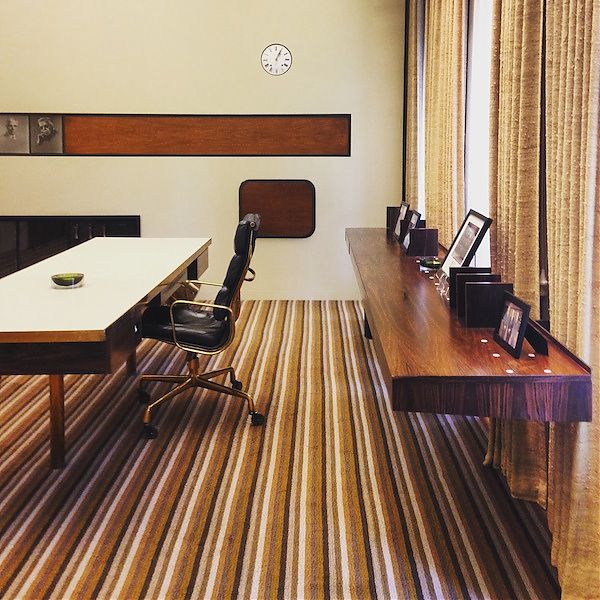
You know about Alexander Girard’s interiors for the Miller House, which I shared in this post. But did you also know he designed office interiors for two of J. Irwin Miller’s businesses, Irwin Management and Cummins Inc., as well as accessories for Eero Saarinen’s North Christian Church? He did, fitting his flamboyant modernist decoration inside a pair of Victorian storefronts on Columbus, Indiana’s main street. In the essay on Girard I will be writing for the Vitra Design Museum I will analyze these projects in more depth, but in the meantime I wanted to share a few of the striking details of these projects that remain intact. The offices were designed and constructed between 1960 and 1972, so you have to imagine these discussed in the context of corporate modern interiors at the Seagram Building, CBS and the Ford Foundation. Those of you who know Girard’s textile designs will recognize the checkerboard floor as closely related to his Checker upholstery fabric, reissued by Maharam, and the striped rug as part of the family of his tonal Mexicottons.
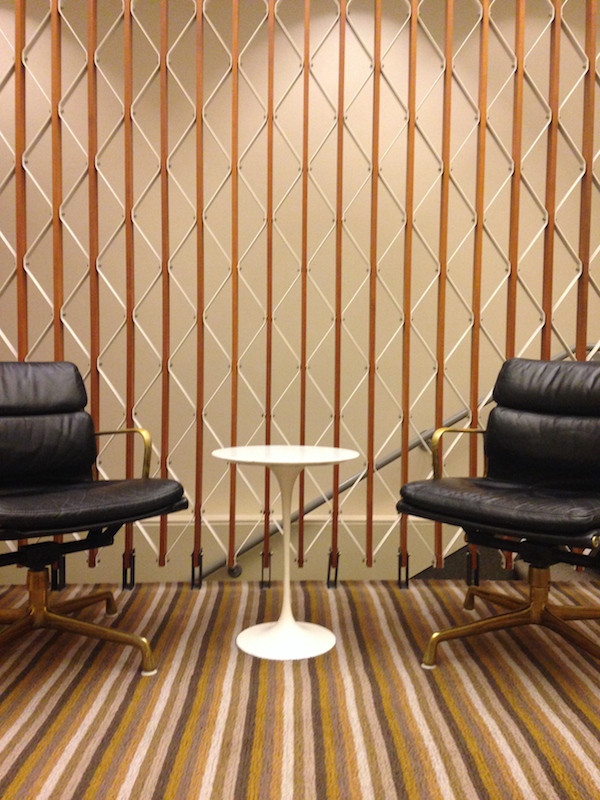
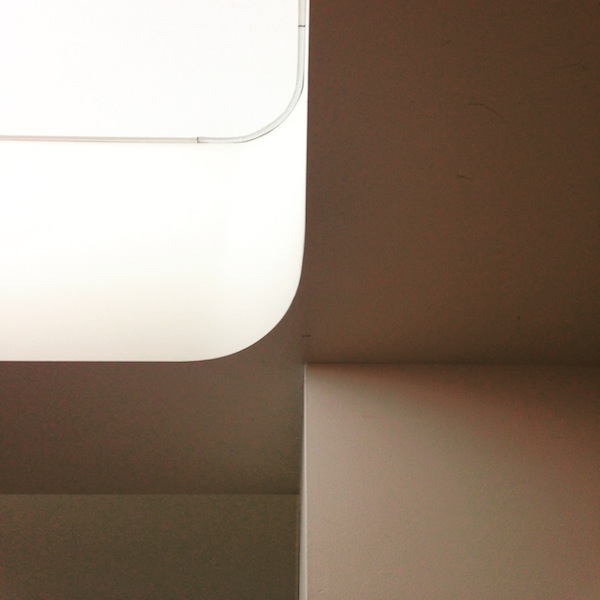
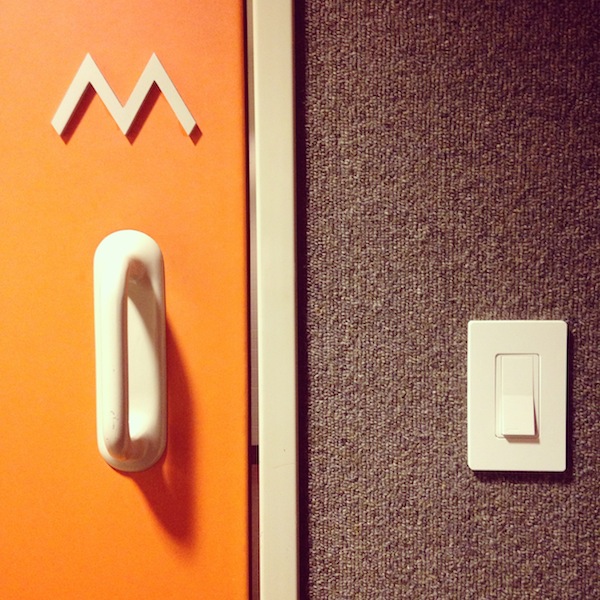

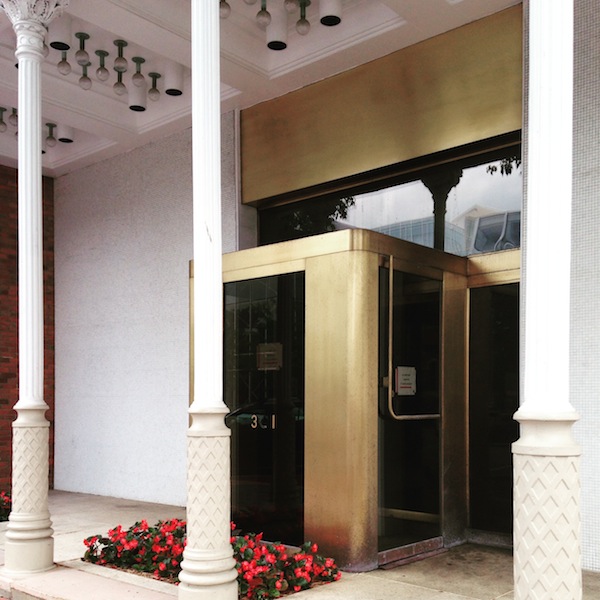
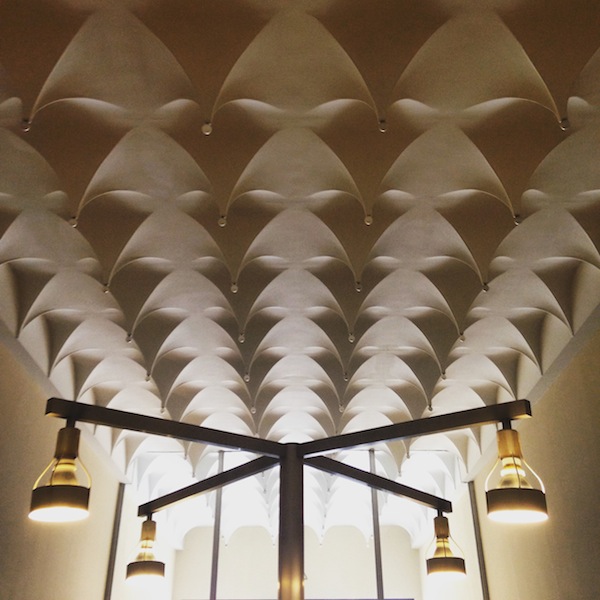


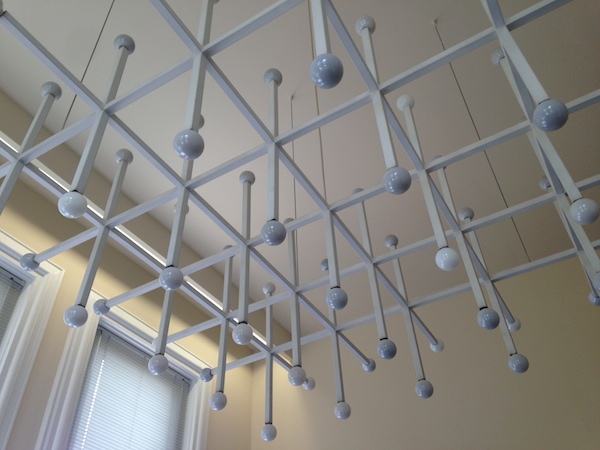
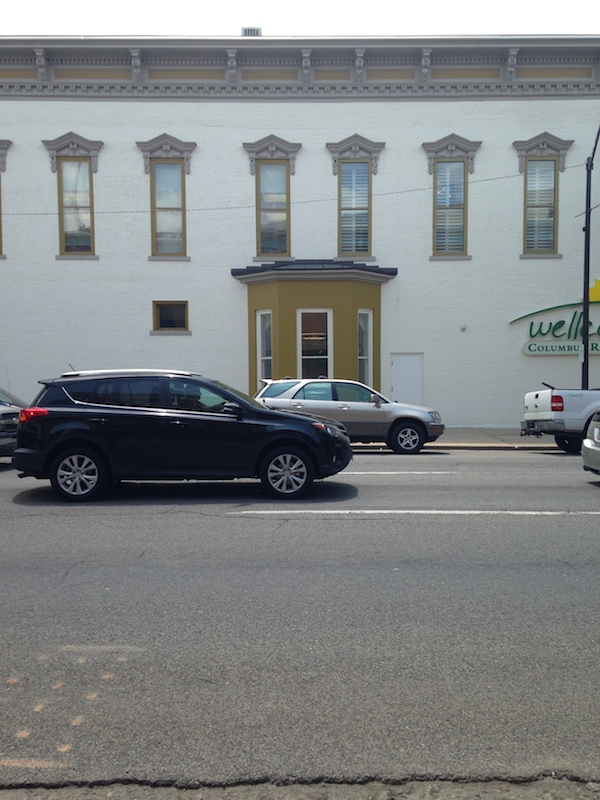

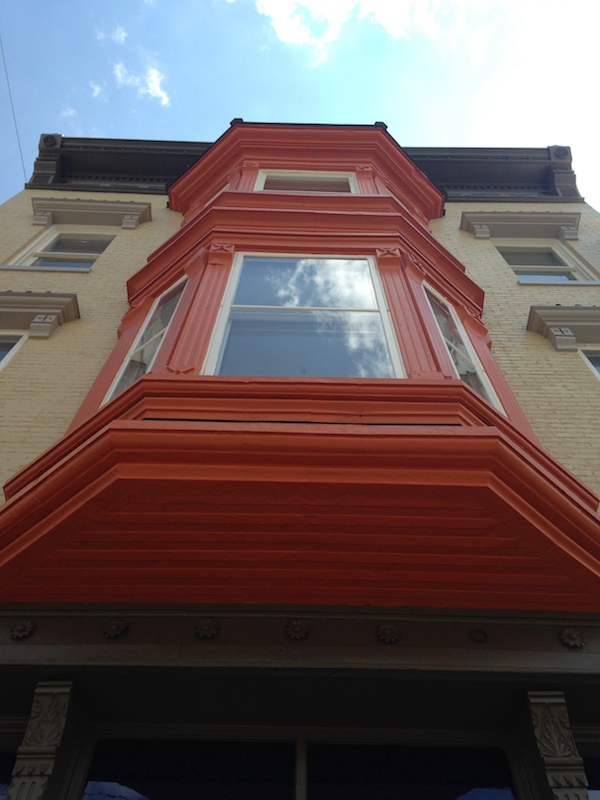
The Brooklyn Bridge Deserves a Scenic View District of Its Own
Drone photo by Aymann Ismail for Curbed.
My first sighting of a selfie stick in the wild was on the Brooklyn Bridge. Three European tourists gathered themselves together, with one tourist acting as a pivot point, angling the rod so that their three heads would be framed by one of the bridge’s distinctive pointed stone arches. In most ways, the Brooklyn Bridge is the best New York City icon on which to selfie with a stick. The Statue of Liberty is usually too far away; the spire of the Empire State Building, from the observation deck, too near. Central Park is very nice but, ultimately, grass is grass. The bridge has natural lighting, built-in framing, and instant recognition. Being yelled at by a biker as you infringe on her lane for a photo could be seen as a New York hazing ritual.
The Brooklyn Bridge belongs to all of us, as an icon, as infrastructure, as a backdrop for snapshots and proposals and commutes. Which is why it needs protection. Not from being torn down or allowed to rot, like less photogenic and accessible contemporaries, but protection from love—the obsessive kind of love that wants to glom on to its glamor and give little in return. Right now, a series of buildings and proposals are chipping away at the experience of the bridge, blocking sidelong glances down the Brooklyn Heights Promenade, and scrubbing from view the masts and cable stays that suggests an earlier New York. It’s time for the bridge to get a Special Scenic View district of its own, a two-way district that preserves sight lines both to and from its mighty span.
On X
Follow @LangeAlexandraOn Instagram
Featured articles
CityLab
New York Times
New Angle: Voice
Getting Curious with Jonathan Van Ness